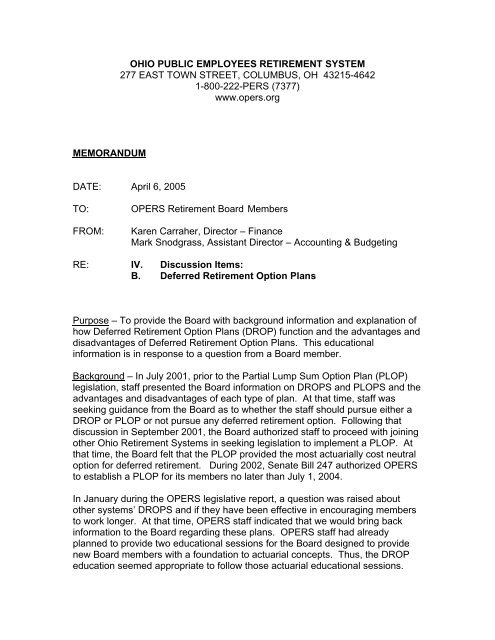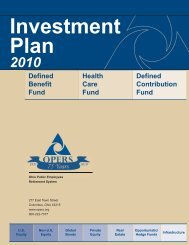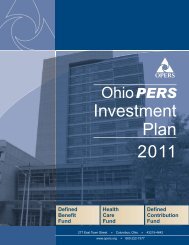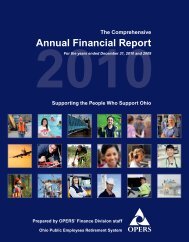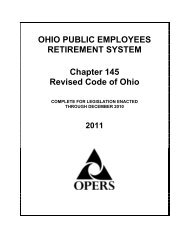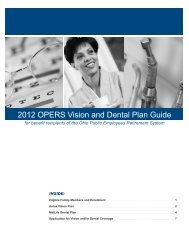DROP - OPERS
DROP - OPERS
DROP - OPERS
You also want an ePaper? Increase the reach of your titles
YUMPU automatically turns print PDFs into web optimized ePapers that Google loves.
MEMORANDUM<br />
OHIO PUBLIC EMPLOYEES RETIREMENT SYSTEM<br />
277 EAST TOWN STREET, COLUMBUS, OH 43215-4642<br />
1-800-222-PERS (7377)<br />
www.opers.org<br />
DATE: April 6, 2005<br />
TO: <strong>OPERS</strong> Retirement Board Members<br />
FROM: Karen Carraher, Director – Finance<br />
Mark Snodgrass, Assistant Director – Accounting & Budgeting<br />
RE: IV. Discussion Items:<br />
B. Deferred Retirement Option Plans<br />
Purpose – To provide the Board with background information and explanation of<br />
how Deferred Retirement Option Plans (<strong>DROP</strong>) function and the advantages and<br />
disadvantages of Deferred Retirement Option Plans. This educational<br />
information is in response to a question from a Board member.<br />
Background – In July 2001, prior to the Partial Lump Sum Option Plan (PLOP)<br />
legislation, staff presented the Board information on <strong>DROP</strong>S and PLOPS and the<br />
advantages and disadvantages of each type of plan. At that time, staff was<br />
seeking guidance from the Board as to whether the staff should pursue either a<br />
<strong>DROP</strong> or PLOP or not pursue any deferred retirement option. Following that<br />
discussion in September 2001, the Board authorized staff to proceed with joining<br />
other Ohio Retirement Systems in seeking legislation to implement a PLOP. At<br />
that time, the Board felt that the PLOP provided the most actuarially cost neutral<br />
option for deferred retirement. During 2002, Senate Bill 247 authorized <strong>OPERS</strong><br />
to establish a PLOP for its members no later than July 1, 2004.<br />
In January during the <strong>OPERS</strong> legislative report, a question was raised about<br />
other systems’ <strong>DROP</strong>S and if they have been effective in encouraging members<br />
to work longer. At that time, <strong>OPERS</strong> staff indicated that we would bring back<br />
information to the Board regarding these plans. <strong>OPERS</strong> staff had already<br />
planned to provide two educational sessions for the Board designed to provide<br />
new Board members with a foundation to actuarial concepts. Thus, the <strong>DROP</strong><br />
education seemed appropriate to follow those actuarial educational sessions.
Issues -- The goal of the <strong>DROP</strong> presentation is to educate the Board on how<br />
<strong>DROP</strong> plans work, the types of <strong>DROP</strong> plans, the advantages and disadvantages<br />
associated with <strong>DROP</strong> plans and the actuarial considerations with <strong>DROP</strong> plans.<br />
Next Steps -- Based on the educational session, staff would like feedback from<br />
the Board on whether to pursue any further delayed retirement options.<br />
.
Deferred Retirement Option Plans<br />
<strong>DROP</strong>’s<br />
Forward <strong>DROP</strong>’s and Back <strong>DROP</strong>’s<br />
Gabriel, Roeder, Smith and Company<br />
April 20, 2005
What is a <strong>DROP</strong>?<br />
Deferred Retirement Option Plan<br />
• A Forward <strong>DROP</strong> is a plan where the member<br />
continues to work and the accrued pension benefit is<br />
“paid” into a special account that is maintained until<br />
the member actually retires.<br />
• A Back <strong>DROP</strong> is a plan where, at time of retirement,<br />
members may choose to have their benefits refigured as<br />
though they had entered a forward <strong>DROP</strong> in the past.<br />
• In either case, the pension becomes frozen at time of<br />
entry into <strong>DROP</strong>.<br />
2
What is a <strong>DROP</strong>?<br />
• Both types of <strong>DROP</strong>s encourage members to work<br />
longer.<br />
• A Forward <strong>DROP</strong> usually places members at risk for<br />
bad decisions. For example, in most forward <strong>DROP</strong>s,<br />
members who have large pay increases following<br />
<strong>DROP</strong> entry, cannot “un <strong>DROP</strong>” and have the final<br />
average salary increased.<br />
• In a Back <strong>DROP</strong> members have all facts available at<br />
time of retirement and simply choose the best plan.<br />
3
What is a <strong>DROP</strong>?<br />
• Back <strong>DROP</strong>s are inherently more costly,<br />
because the Back <strong>DROP</strong> Plan Sponsor<br />
assumes the risk. Decisions are always in the<br />
member’s favor.<br />
4
The PLOP Alternative<br />
• PLOP stands for “Partial Lump Sum Option”<br />
• Members can take part of the monthly benefit in<br />
a lump sum.<br />
• Future benefits are reduced to account for the<br />
lump sum already received.<br />
• Like a traditional <strong>DROP</strong>, a PLOP provides a<br />
lump sum at retirement.<br />
• Unlike a <strong>DROP</strong>, it is easy to design a cost<br />
neutral PLOP.<br />
5
The <strong>OPERS</strong> PLOP<br />
• Senate Bill 247 created the <strong>OPERS</strong> PLOP<br />
effective 1/1/2004.<br />
• If the retiring member elects to PLOP, he or she<br />
must select a lump sum that is between 6 and 36<br />
months worth of benefit.<br />
• Future benefits are actuarially reduced.<br />
• The PLOP provides a valuable choice to the<br />
retiree, without adding cost to <strong>OPERS</strong>.<br />
6
<strong>DROP</strong>s and Cost Neutrality<br />
A common design mission of <strong>DROP</strong>s is to make them<br />
cost neutral. Ways for a <strong>DROP</strong> plan to be cost neutral:<br />
1. Design the plan so that everyone gets exactly the same<br />
actuarial value regardless of <strong>DROP</strong> election. A partial lump<br />
sum option (PLOP) does that nicely.<br />
2. Design the plan so that there are winners and losers. The<br />
losers pay for the benefits received by the winners. This is<br />
unpopular with the losers.<br />
3. Design a plan that produces a heavy incentive to remain<br />
working longer. Incentives to work longer tend to be<br />
unpopular.<br />
7
<strong>DROP</strong> Perspectives<br />
Following Election of <strong>DROP</strong>:<br />
• Retirement system’s perspective: Person<br />
electing the <strong>DROP</strong> appears to be retired.<br />
• Employer’s perspective: Person electing the<br />
<strong>DROP</strong> may appear to be an active employee<br />
for some purposes and a retired employee for<br />
others.<br />
8
<strong>DROP</strong> Operation<br />
• Upon satisfaction of eligibility conditions:<br />
– Pension is frozen on the date of <strong>DROP</strong> participation.<br />
– <strong>DROP</strong> account is created and credited with a % of the<br />
frozen monthly pension during the remaining period of<br />
employment. The % is often less than 100%.<br />
– May also be credited with employer and/or employee<br />
contributions and/or interest credits during <strong>DROP</strong> period.<br />
– At actual retirement member receives monthly pension<br />
plus <strong>DROP</strong> account (lump sum or annuity).<br />
9
Conditions Leading to <strong>DROP</strong><br />
• Plan includes maximum benefit (100% of<br />
pay). Can act as a benefit enhancement.<br />
• Want to induce people to work longer<br />
• More choices are better<br />
• Everyone else has one<br />
10
<strong>DROP</strong> Variations<br />
• <strong>DROP</strong> account is credited with payments for up to a<br />
maximum number of (e.g., 5) years.<br />
• Sometimes a minimum number of years in <strong>DROP</strong> is<br />
required, but what happens if a person <strong>DROP</strong>s and then<br />
does not stay the minimum?<br />
• Some provide a maximum <strong>DROP</strong> participation period.<br />
What happens if a person overstays the maximum?<br />
• <strong>DROP</strong> account is frozen after a cut off date.<br />
• <strong>DROP</strong> interest credited at a fixed rate (e.g., 7%).<br />
• Variable rates or self-directed accounts may be<br />
feasible.<br />
11
Alternatives Upon Actual Retirement<br />
• Lump sum distribution of <strong>DROP</strong> account<br />
balance, and pay the appropriate taxes.<br />
• Roll over account balance to an eligible plan<br />
or IRA.<br />
• Convert account balance to a monthly benefit<br />
to enhance the regular pension.<br />
• Leave the account balance in the retirement<br />
system and draw down a portion in periodic<br />
payments.<br />
12
Potential Benefits to Members<br />
• <strong>DROP</strong> is a means of providing for a lump sum<br />
distribution of a portion of a member’s interest in a<br />
retirement plan.<br />
• <strong>DROP</strong> participation may enhance the member’s overall<br />
benefit value, particularly if salaries near retirement are<br />
not increasing, or there is a cap on accruals.<br />
• People can continue working in a job they like without<br />
forfeiting retirement benefits. In other words, they can<br />
effectively draw both pension benefits and working pay<br />
at the same time.<br />
13
Possible Disadvantages for Members<br />
• Eligibility conditions often are such that only a small subset<br />
of members actually benefit from the plan.<br />
• Younger members may see impaired promotional<br />
opportunities.<br />
• Plan benefit increases during the <strong>DROP</strong> period are generally<br />
not passed on to <strong>DROP</strong> participants.<br />
• Pay increases during the <strong>DROP</strong> period are not reflected in the<br />
actual benefit at retirement.<br />
• By foregoing future benefit accruals, future cost-of-living<br />
adjustments on the missing accruals are also lost.<br />
• <strong>DROP</strong> participation can lead to lesser total benefit values,<br />
even in some generous plans.<br />
14
Possible Disadvantages for Members<br />
• If the <strong>DROP</strong> percentage is less than 100%,<br />
members may feel penalized for participating.<br />
• By electing the <strong>DROP</strong> lump sum, the member’s<br />
future pension payments will replace less of preretirement<br />
income.<br />
• Lump sum might be used for non-retirement<br />
purposes.<br />
• Might be forced to work beyond planned retirement<br />
date in order to get <strong>DROP</strong>.<br />
15
Potential Benefits to Plan Sponsors<br />
• Means of offering additional benefit choices<br />
at little cost (maybe).<br />
• Valuable long-service employees may be<br />
induced to delay retirement.<br />
• Employer can plan for the replacement of<br />
long service employees.<br />
16
Disadvantages for Plan Sponsors<br />
• Plan administration is more complex and<br />
costly.<br />
• It is difficult to design a truly cost-neutral<br />
plan that is popular.<br />
• Payroll costs could rise if people extend their<br />
working careers.<br />
• Very large lump sums can accrue in <strong>DROP</strong><br />
plans leading to unfavorable publicity.<br />
17
Cost Neutral ?<br />
• Actuaries often get asked to design a <strong>DROP</strong><br />
that is cost neutral.<br />
• What does “Cost Neutral” mean to an<br />
actuary?<br />
18
Cost Neutral<br />
• Current contribution rates remain unchanged.<br />
• Projected patterns of future contributions rates remain<br />
unchanged.<br />
• There could be other definitions.<br />
• Usually plans have a provision to review the cost<br />
neutrality or lack thereof after a period of years.<br />
• Such reviews are difficult and subjective. Difficult to<br />
determine what would have happened if there had been<br />
no <strong>DROP</strong>.<br />
19
Actuarially Cost Neutral<br />
• If people retire earlier than would otherwise be the<br />
case, the plan cannot pay 100% of the benefit into the<br />
<strong>DROP</strong> account and still be cost neutral.<br />
• If people retire earlier, replacements will be hired<br />
sooner and retire sooner. Thus, more people will draw<br />
benefits.<br />
Therefore, each person’s benefit must be reduced to<br />
keep the Plan cost neutral. The reduction could be<br />
severe.<br />
Members will tend to not like this plan.<br />
20
Actuarially Cost Neutral<br />
This implies a long service requirement for<br />
participation, so that people cannot draw<br />
benefits much sooner than they would have<br />
anyway, and possibly a minimum participation<br />
period to ensure that people will retire later.<br />
21
Corollary<br />
• If later retirement is not an objective, a partial<br />
lump sum option (PLOP) is an alternative to a<br />
<strong>DROP</strong>. (Currently available to members of<br />
<strong>OPERS</strong>.)<br />
•Why?<br />
– It is easy to understand and to administer.<br />
– It has fewer traps.<br />
– Benefits are preserved but have been restructured<br />
into a more desirable form.<br />
22
Gray Cases<br />
• It is not always possible to predict how the<br />
<strong>DROP</strong> affects human behavior. This is why<br />
many plans that are supposed to be cost<br />
neutral pay less than 100% into the <strong>DROP</strong><br />
account.<br />
23
<strong>DROP</strong> Conclusions<br />
• If a <strong>DROP</strong> causes people to retire later than would<br />
otherwise be the case, the <strong>DROP</strong> can pay people more<br />
in total than they would have received without it and it<br />
can still be cost neutral.<br />
• If a <strong>DROP</strong> causes people to retire earlier than would<br />
otherwise be the case, it must pay each person less in<br />
total than if there had been no <strong>DROP</strong> in order to be<br />
cost neutral.<br />
24
<strong>DROP</strong> Conclusions<br />
• If a <strong>DROP</strong> has no effect on the timing of<br />
retirements, the <strong>DROP</strong> must create winners and<br />
losers or be arranged so that each member<br />
receives the same total benefit each would have<br />
received if there had been no <strong>DROP</strong>, if the plan<br />
is to be cost neutral.<br />
– The only difference will be the lump sum option.<br />
– Can be accomplished with a partial lump sum option<br />
(PLOP) without a <strong>DROP</strong>.<br />
25
Major Design Issues<br />
Determining the relationship between retirement<br />
eligibility vs. <strong>DROP</strong> eligibility<br />
• How long can members stay in a <strong>DROP</strong>?<br />
• How long must members stay in a <strong>DROP</strong>?<br />
• What percent of accrued benefit goes into<br />
<strong>DROP</strong>?<br />
26
Other Design Issues<br />
• Death or disability during <strong>DROP</strong><br />
• Benefit increases during <strong>DROP</strong><br />
• Accrued sick/vacation leave<br />
• Interest credits on <strong>DROP</strong> account<br />
• Distribution options<br />
• Un-dropping, Backdropping<br />
27
Important Design Principle<br />
• In order for a <strong>DROP</strong> Plan to be “cost neutral” in<br />
the actuarial sense, and pay higher benefits to<br />
people who elect it, there must be at least one<br />
major design issue that at least some people<br />
don’t like.<br />
28
<strong>DROP</strong> Valuations<br />
• In order to evaluate the effect of a <strong>DROP</strong>, the<br />
actuary must make an assumption about the<br />
extent to which the <strong>DROP</strong> will cause people to<br />
alter their planned retirement date.<br />
– This is a very important assumption that materially<br />
affects the end result.<br />
– It is important that the Board and the Actuary agree<br />
on this assumption in advance.<br />
29
#1 - State Plan<br />
– Forward <strong>DROP</strong><br />
Sample <strong>DROP</strong> Plans<br />
– 28 years of service required for eligibility<br />
– <strong>DROP</strong> period - maximum 5 years<br />
– 7.75% interest credit. This caused a lot of controversy during<br />
years when the investment portfolio was losing money,<br />
– 75% of accrued pension credited to <strong>DROP</strong> account<br />
– Lump sum only<br />
30
#2 - State Plan<br />
– Forward <strong>DROP</strong><br />
Sample <strong>DROP</strong> Plans<br />
– Age 62 or 30 years of service required for eligibility<br />
– <strong>DROP</strong> period - maximum 5 years<br />
– 6.50% interest credit<br />
– 100% of accrued pension credited to <strong>DROP</strong> account<br />
– Lump sum or annuity options<br />
31
Sample <strong>DROP</strong> Plans<br />
#3 - State Police/Fire Plan<br />
– Forward <strong>DROP</strong><br />
– Age 48 and 25 years of service required for eligibility<br />
– <strong>DROP</strong> period - minimum 3 years, maximum 8 years<br />
– 5.0% interest credit<br />
– 100% of accrued pension credited to <strong>DROP</strong> account<br />
– Increasing portion of Member contribution credited to <strong>DROP</strong><br />
accounts.<br />
– Lump sum or periodic payments<br />
32
Sample <strong>DROP</strong> Plans<br />
#4 - State General Employees Plan<br />
–Back <strong>DROP</strong><br />
– Must be 2 years past normal retirement eligibility<br />
– <strong>DROP</strong> period - minimum 2 years, maximum 5 years<br />
– 0.0% interest credit<br />
– 90% of accrued pension credited to <strong>DROP</strong> account<br />
– Lump sum or periodic payments<br />
33
#5 - City Plan<br />
– Forward <strong>DROP</strong><br />
Sample <strong>DROP</strong> Plans<br />
– Age 55 with 10 years of service or 70 points required for<br />
eligibility<br />
– <strong>DROP</strong> period - maximum 3 years<br />
– Interest based on member investment choices (self-directed)<br />
– 100% of accrued pension credited to <strong>DROP</strong> account<br />
– Lump sum or annuity options<br />
34


